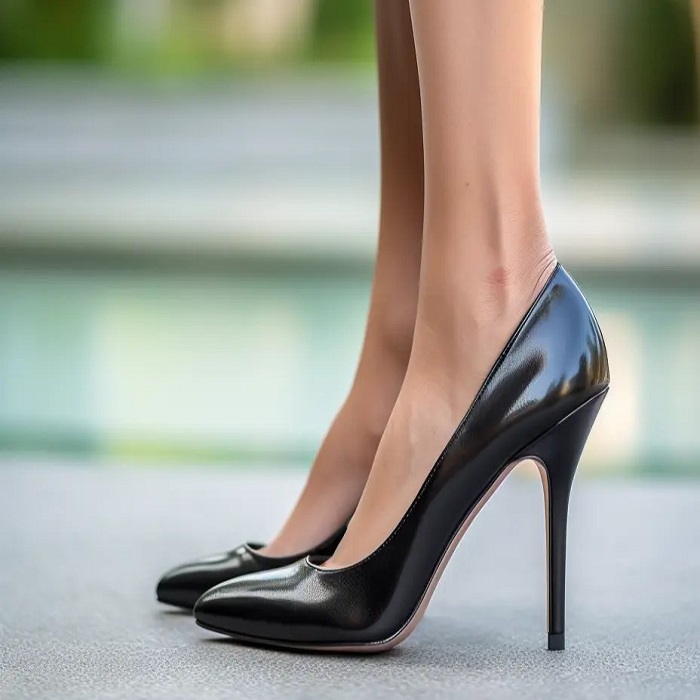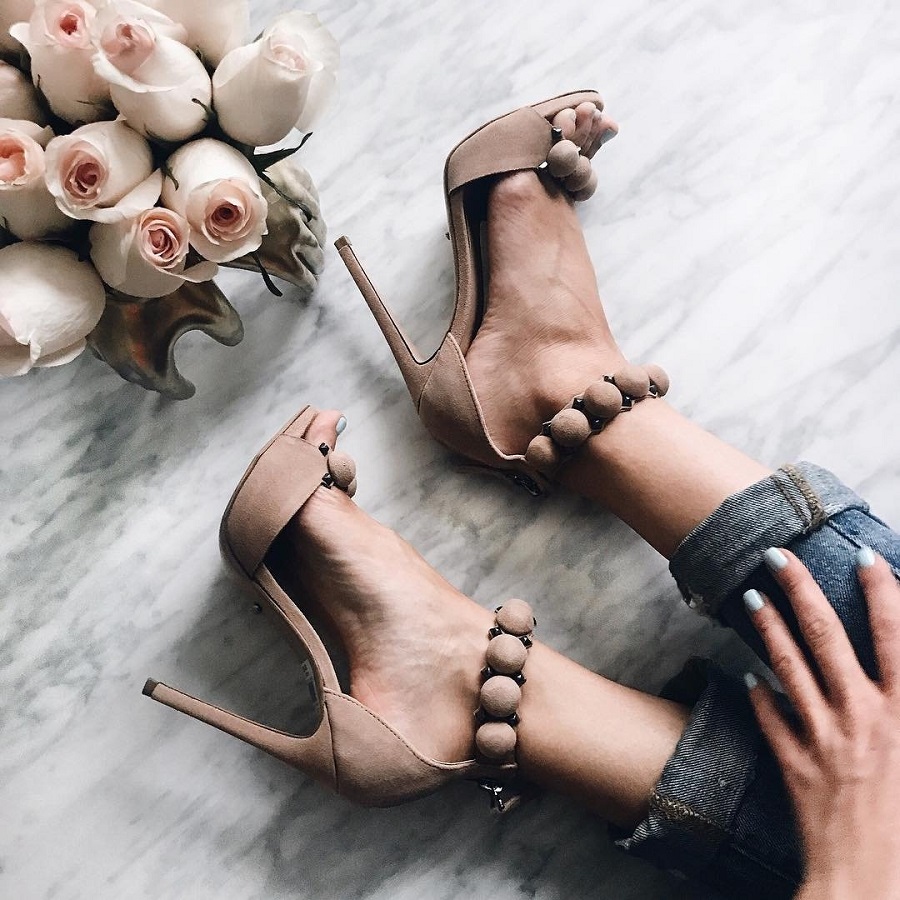Choosing the Right High Heels for Comfort
Choosing the right high heels is crucial for comfort. To minimize pain while wearing heels, consider the following tips:
- Opt for Thick Heels: Select shoes with thicker heels for better balance and less pressure on your feet.
- Heel Height Matters: Choose heels that are not too high. A moderate heel of two to three inches can be elegant yet comfortable.
- Right Size is Vital: Always go for the right size to prevent your feet from sliding forward.
- Consider the Width: If you have wide feet, look for a wider front, or ‘toe box’, to reduce cramping.
- Material Flexibility: Choose heels made of natural materials, as they can adapt to the shape of your feet more easily.
- Ankle Support: High heels with ankle straps or a closed back can provide added stability and support.
- Cushioned Insoles: Go for heels with quality, cushioned insoles that can absorb impact and offer comfort.
- Shoe Shape: Almond or round-toe shoes can be more comfortable than pointy ones and give your toes more room.
By following these guidelines on how to wear high heels without pain, you’re setting yourself up for a stylish day or evening with reduced discomfort.
 Tips for Breaking in New High Heils
Tips for Breaking in New High Heils
Once you’ve chosen your perfect pair of high heels, breaking them in is crucial. Here’s how to make your new heels comfy before you make your grand entrance:
- Wear Them at Home: Start by wearing your high heels around the house. Do this for short periods to avoid blisters.
- Use Thick Socks: Put on thick socks and then your heels. The socks help stretch the material, especially if it’s leather.
- Warm Them Up: Gently heat your heels with a hairdryer. Warm materials expand, offering a little extra room. Do this while wearing thick socks.
- Freeze Some Water: Fill zip-lock bags with water and place them in your heels. Leave them in the freezer. As water turns to ice, it expands, stretching the shoes.
- Use a Shoe Stretcher: Invest in a shoe stretcher. It can widen your heels slowly, reducing the chance of pain.
- Moisturizing the Leather: If your heels are leather, use a leather conditioner. It softens the leather, making it more pliable.
- Walk on Different Surfaces: Practice walking on carpet, hardwood floors, and tiles. Different surfaces prepare your feet for varied textures and impacts.
- Bend and Twist: Work the soles by bending and twisting them. This makes the soles more flexible and comfortable during actual wear.
Remember, take it slow and do not rush the breaking-in process. Patience will lead to a pain-free experience with your beautiful high heels.
The Role of Insoles and Inserts
Insoles and inserts play a vital role in how to wear high heels without pain. These products provide extra cushioning and support, which can make a significant difference in comfort levels. Here are some key points to consider when using insoles and inserts in high heels:
- Extra Padding: High-quality insoles offer additional padding. This reduces the impact on your soles while walking.
- Arch Support: Inserts can provide crucial arch support. This feature minimizes strain on the arches of your feet.
- Heel Cups: Some insoles come with heel cups. They help with heel positioning and can prevent slipping.
- Custom Fits: You can get custom-made insoles tailored to your foot shape. Although pricier, they match your feet’s contours for personalized comfort.
- Shock Absorption: Look for insoles with good shock-absorbing properties. They can lessen the force each time your foot hits the ground.
- Material Choice: Choose insoles made from gel or foam. These materials conform to your feet and provide the best cushioning.
Remember, while insoles and inserts can make a difference, they should fit correctly. Make sure they don’t make your shoes too tight, as this can cause further discomfort. Insert them into your heels before a big event and give yourself time to adjust to the feel. By enhancing the comfort of your high heels with insoles and inserts, you can enjoy elevated style without the usual pain.
Techniques for Walking in Heels to Reduce Discomfort
Mastering the art of walking in high heels is vital to avoid pain. Here’s how you can walk in heels to lessen your discomfort:
- Heel to Toe Movement: Walk heel to toe. This move makes your walk look natural and helps distribute weight more evenly.
- Small Steps: Take smaller steps. It prevents wobbling and maintains your balance while walking in heels.
- Straight Posture: Keep your back straight and shoulders back. A good posture supports your body better and reduces strain on your feet.
- Engage Your Core: Tighten your core muscles. They provide stability and can alleviate pressure on your feet.
- Avoid Rushing: Slow down your pace. Rushing causes you to put extra pressure on your feet and risking pain.
- Pace Yourself: Give your feet rest intervals by sitting whenever possible. This can help to prevent pain from constant standing or walking.
- Practice Regularly: The more you walk in them, the more your feet adapt. Practice walking in heels regularly to improve your comfort level.
Follow these techniques on how to wear high heels without pain. With time, you’ll notice these simple changes make a big difference in your comfort while wearing high heels.
Foot Exercises to Strengthen for High Heel Wear
To rock high heels without pain, strengthen your feet with exercises. Here’s how to boost strength and resilience in your feet:
- Toe Point and Flex: Sit down and stretch your legs out. Point your toes away from you, then flex them back. This exercise improves your toe flexibility.
- Heel Raises: Stand flat on the floor. Lift your heels until you’re on your tip-toes, then lower them. This strengthens your calves and ankles.
- Ankle Circles: Lift one foot off the ground. Rotate the ankle clockwise and then counterclockwise. It helps with ankle mobility and strength.
- Toe Splay: While seated, spread your toes apart as much as possible. Hold the position, then relax. It increases toe control.
- Marble Pickups: Place marbles on the floor. Use your toes to pick them up and place them in a bowl. This boosts toe strength and dexterity.
- Towel Scrunches: Lay a towel on the floor and scrunch it towards you using only your toes. It works the muscles under your feet.
- Walking Barefoot: Spend some time walking barefoot on various surfaces. It strengthens your foot muscles naturally.
Incorporate these foot exercises into your daily routine and notice a difference in how you wear high heels without pain. Regular practice leads to more comfort and better stability in those stylish heels.
The Importance of Varying Your Footwear
When aiming to master how to wear high heels without pain, varying your footwear is crucial. It’s not just about picking the right pair of heels; it’s about giving your feet a break with different types of shoes on different days. Here’s why this strategy is important:
- Reduces Pressure Points: Switching between high heels and flats can alleviate the pressure on the same spots. This helps prevent calluses and blisters.
- Promotes Muscle Recovery: Your foot muscles can recover when you alternate your shoes. This means less strain and pain in the long run.
- Allows for Better Foot Health: Changing your footwear helps in maintaining better overall foot health. It encourages blood circulation and reduces the risk of deformities.
- Increases Footwear Lifespan: Your high heels will last longer if you don’t wear them every day. Giving them time to air out reduces wear and tear.
- Improves Adaptability: Your feet become more adaptable to various styles and heel heights. This flexibility can enhance your comfort when you do wear high heels.
Remember, when you plan how to wear high heels without pain, consider giving your favorite pair a rest. Rotate your shoes regularly, and your feet will thank you.
Preparing Your Feet Before a High Heels Event
Preparing your feet before a high heels event can significantly reduce discomfort. Here’s a simple routine to get your feet ready:
- Moisturize Your Feet: Apply a good foot cream to keep your skin soft.
- Trim Your Toenails: Short, well-shaped nails prevent pressure and nail damage.
- Stretch Your Feet: Roll a tennis ball under your foot to loosen tight muscles.
- Elevate Your Legs: Before the event, rest with your legs up to decrease swelling.
- Hydrate: Drink plenty of water to keep your feet from bloating.
- Select the Right Stocking: Thin, seamless stockings can prevent friction.
Following these steps on how to wear high heels without pain ensures that your feet are in prime condition before you step into your heels. Reduce the risk of blisters, cuts, and discomfort by taking care of your feet. They’re the foundation of a pain-free high heels experience.
When to Seek Professional Help for Foot Pain
Despite following all these steps on how to wear high heels without pain, there might be occasions when you need to seek professional help. Monitoring your feet’s condition is crucial, and knowing when to consult a healthcare provider can prevent long-term damage. Here are instances when professional advice is necessary:
- Persistent Pain: If you experience ongoing pain in your feet after wearing high heels, it’s time to consult a doctor.
- Joint or Muscle Injury: Signs of an injury, such as severe pain, swelling or difficulty moving, indicate a need for medical attention.
- Numbness or Tingling: These sensations could be a sign of nerve damage or circulation issues, which require a professional’s care.
- Abnormal Growth or Deformities: Bunions, hammertoes, or other changes in foot shape should be examined by a foot specialist.
- Recurring Blisters or Calluses: If you often get blisters or calluses despite protective measures, a podiatrist might offer remedies.
- Change in Walking Pattern: If you notice changes in your walking style or balance problems while wearing high heels, seek advice.
Don’t ignore foot pain or discomfort. Early intervention is key to maintaining foot health and ensuring that your style choices do not lead to severe issues. If you encounter any of these problems, schedule a visit with a healthcare provider to get back on your feet, pain-free, as soon as possible.

